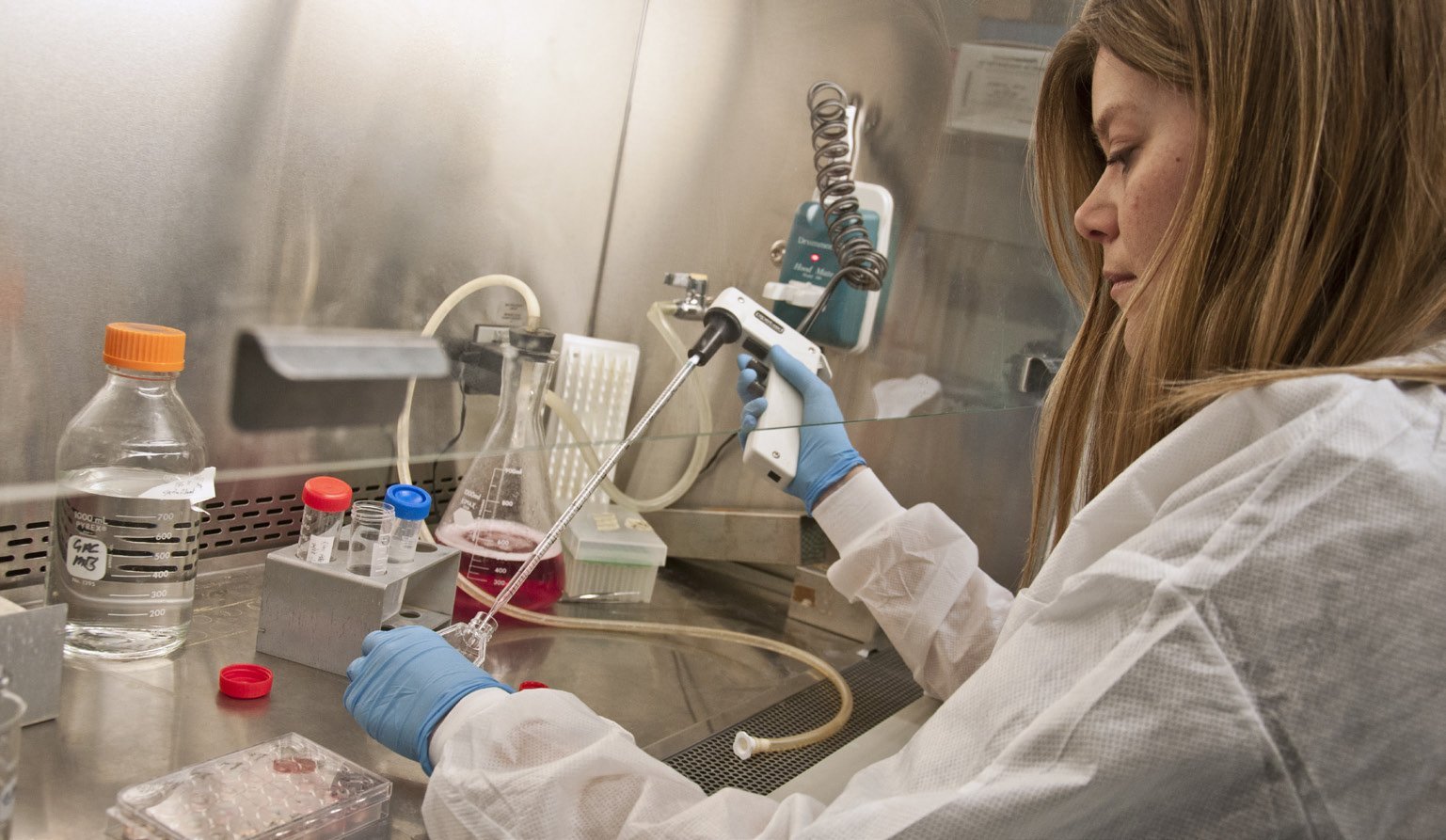Center for Integrated Biomedical and Rural Health Research
The Center for Biomedical and Rural Health Research encompasses mentorship and collaboration between faculty in the established partnership between the McLaughlin Research Institute, the Touro University College of Osteopathic Medicine - Montana, and the Benefis Healthcare System
The overall goal of this Center of Biomedical Research Excellence (COBRE) center is to strengthen the biomedical research infrastructure in Montana with a focus on the central, multi-disciplinary theme of Integrated Biomedical and Rural Health Research, a subject that is both sufficiently broad to enable recruitment of diverse faculty and sufficiently focused to build cohesiveness around a common goal to address rural health in a multi-disciplinary fashion that includes basic, translational and clinical studies. The Center for Biomedical and Rural Health Research is the largest comprehensive provider in central Montana extending across 38,000 square miles with outreach services present in 94 percent of Montana’s counties.
We begin our discussion
of the MRI with a picture.
Throughout the school year, outside our windows at the MRI, we see the yellow school bus pick up the kids from the apartments that house low-income parents who harbor somewhat undefined hopes of a better life for their children (picture to right).
The MRI was launched in 1954 with the recruitment of a physician scientist, Dr. Ernst Eichwald, to Montana Deaconess Hospital. Dr. Eichwald was recruited with resources to continue his pioneering research on tissue transplantation and organ rejection2. He built the MRI on these resources and was founder and editor of the journal, Transplantation Bulletin, and its successor Transplantation for more than 30 years. He was also the scientific mentor to the first high school intern at the MRI, Irving Weissman, who is now the Director of the Stanford University Ludwig Center for Cancer Stem Cell Research and Medicine and an endowed professor in Cancer Research and Developmental Biology at Stanford.
Over its 68-year history, 5 directors/presidents have led the MRI: Following Ernst Eichwald, Jack Stimpfling solidified the expertise in mouse models, George Carlson focused on prion diseases and neurodegeneration, Michael Kavanaugh expanded the translational genetics and electrophysiological investigations, and Renee Reijo Pera is focusing on using her experience in basic and translational research in women’s health, early development and outcomes in disease to expand the mission of the MRI through partnerships with neighboring organizations in service to rural Montana. While the mission of the MRI has a central focus on providing scientific research access and opportunity, especially through internship and employment in scientific research, the quality of the science has also been exemplary.
MRI scientists have been authors of more than 650 publications that document seminal translational discoveries including:
Discovery of male-specific antigen, H-Y and contributions to protocols for organ transplantation 2-4
Genetic dissection of the mouse major histocompatibility complex, H2, and identification and characterization of H2 recombinants with development of a panel of congenic strains 5, 6
Genetic determinants in peripheral nerve development 7
Use of loss of heterozygosity (LOH) in murine mitotic linkage maps 8
Genes essential for early steps of sensory neurogenesis in cranial placodes 9
Gene dose effects in Ir gene-controlled systems 5
Protection against cognitive and electrophysiological impairments in Tg2576 APP transgenic mice 10
Glia to axon RNA transfer 11
Increased plaque burden in brains of APP mutant MnSOD heterozygous knockout mice 12
Systems biology and the discovery of diagnostic biomarkers and identification of subnetworks representing major dynamics using gene expression data 13
Synaptic alterations in the rTg4510 mouse model of tauopathy 14
Quantitative trait loci affecting prion incubation time in mice 15
Cerebrospinal fluid–based kinetic biomarkers of axonal transport in monitoring neurodegeneration 16
Tet enzymes essential role in early embryogenesis and completion of embryonic genome activation with applications of DNA methylation reprogramming to human development 17
High resolution time-course mapping of early transcriptomic, molecular and cellular phenotypes in Huntington’s disease CAG knock-in mice across multiple genetic backgrounds 18
Requirement for the familial dysautonomia disease gene IKBKAP in the developing and adult mouse central nervous system and phenotypes associated with deletion 19, 20
Prion protein lowering as a disease-modifying therapy across prion disease stages, strains and endpoints 214
Therapeutic trial of anle138b in mouse models of genetic prion disease 22
A ubiquitin-based mechanism for the oligogenic inheritance of heterotaxy and heart defects 23
Gene-teratogen interactions that alter Hedgehog signaling strength and penetrance of birth defects 24
Action of RML prions through Mahogunin and Attractin-independent pathways 25
Identification of DOT1L inhibitor in a screen for factors that promote dopaminergic neuron survival 26
Loss of SOX10 function in spongiform neurodegeneration in gray tremor mice 27
Regional variability, genotypic effects, and pharmacodynamics on prion protein concentration in the CNS 28

Goals of the CIB-RHR
-
We focus on building capacity in research on health problems that are especially of concern and/or prevalence in rural environments with three specific aims to: 1) Enhance the success of Research Project Leaders (RPLs) along the integrated trajectory from bench to translational animal models, to clinical applications. 2) Recruit a minimum of eight additional faculty, in Phase I, as RPLs and Pilot Project Investigators (PPIs) to increase the number of investigators, and their scope and impact, in integrated biomedical research. 3) Build and maintain two critical core facilities that support expansion of research infrastructure.
-
To accomplish our aims, we begin with four initial projects focused on neurological diseases, diseases that are common and distinctively devastating, in rural environments: Neutrophil apoptosis in Alzheimer’s disease pathogenesis, age-related macular degeneration and exosome release, misfolded SOD-1 and α-synuclein proteins in idiopathic Parkinson’s disease (PD), and comprehensive phenotypic profiling of Chronic Wasting Disease (CWD). Each project is led by a new or an early-stage investigator with an engaged mentoring team specifically tailored to their career development. Supporting these projects are two cores: The Administrative Core and the Gene Editing and Mouse Models Assessment (GEMMA) Core.
-
This Center is significant as it establishes a unique and sustainable center that serves the two primary purposes of supporting career development of new and early-stage investigators in a unique geographical and socio-cultural area of Montana and of advancing our understanding of conditions of special concern and/or prevalence in rural communities.
The application is innovative in multiple aspects but especially as it: 1) Taps into the strengths and resources of an extensive and under-utilized sector of the healthcare community through a partnership between an independent nonprofit research organization, an osteopathic medical campus and a rural-serving healthcare system, and 2) serves the dual purpose of providing unprecedented opportunities for expansion of biomedical research, talent recruitment and innovation in a rural region of the United States while also providing the physical and intellectual presence in situ that is required to increase public trust in biomedical research in the northern Rocky Mountain front and adjacent communities.

The goal of this center is to build research capacity in Montana through establishment of a formal Center for Integrated Biomedical and Rural Health Research (CIB-RHR) that integrates biomedical research at the level of the individual investigator, regional biomedical centers and across disciplines.
The importance of this goal is illustrated by a recent report from the American Association of Medical Colleges (AAMC) which indicated that medical science today faces an unprecedented credibility crisis that threatens protection of people’s health1. Further the AAMC recommends that scientists address diverse forces that fuel mistrust. We, and others, have suggested that trust in medical science requires that we are present – physically and intellectually rather than just virtually — in rural communities across the nation.
Thus, we are committed to our goals to provide the highest quality research possible in the McLaughlin Research Institute (MRI) in situ in Great Falls, MT.
Rebecca Brown, RN
Research Director, CIB-RHR
Clinical Research and Occupational Health Coordinator





